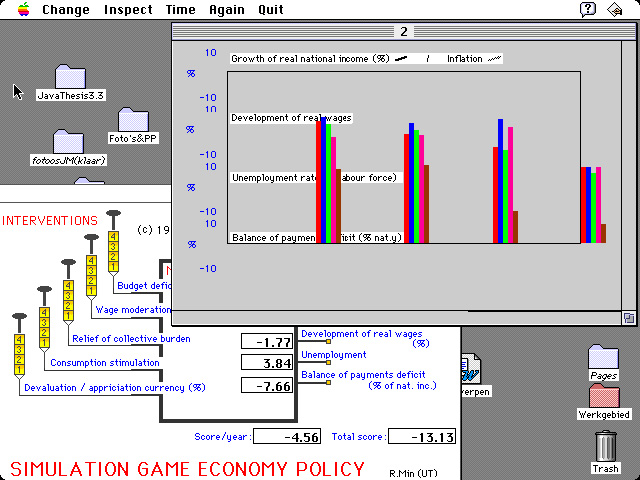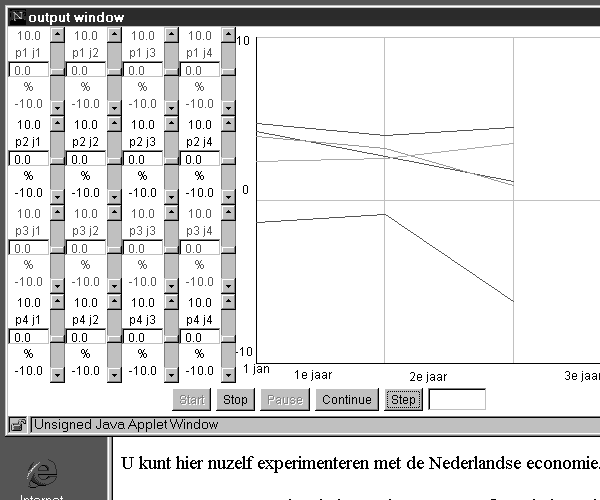
Figure 8.1 All the pages of a old version of the computer simulation program ECONOMY, version MacTHESIS (1995).
This chapter discusses:
Introduction
Economics teaching deals with concepts that are described in a
purely quantitative way. Abstract and rather complex mathematical models
of economic systems are important in teaching topics from micro-economics
(e.g. the relations between profit, demand, cost, production level and
price) as well as in teaching topics from macro-economics (e.g. the
behaviour of the national economy in pursuit of measurements changing parameters
like taxes, national product, employment or government budget). The relations
are usually described in the form of discrete mathematical formula. An
aptitude for mathematics and abstract thinking is a prerequisite for understanding
these relationships. With regard to this prerequisite economics teaching
can be compared with chemistry and physics teaching.
In practice the models are usually taught in a purely theoretical way in economics teaching. However, according to many learning theories a phase of active experimentation, enabling the students to gain personal experience, is essential for the construction of an adequate mental model by the students. The necessity of active experimentation is one of the main motives for the introduction of experiments with systems kept under controlled conditions in the physics curriculum and in the chemistry curriculum. However, experiments with economic systems similar to the practical work that is done in science teaching, are not possible.
The application of computer simulations of economic systems for educational purposes may be a means to overcome this problem. By using such a computer program, the student can learn the operation of economic mechanisms in a very active way. He or she will get a continuous feedback on the decisions that he or she makes based on his hypotheses about the operation of the economic system, enabling him to perfect his mental model based on (almost) concrete experience.
Simulations of economic systems can be used in a game-like context.
When this approach is followed, the student is allowed to control the simulated
system (e.g. a commercial enterprise or the national economy) in order
to achieve a predestine commercial or political goal (like maximizing the
profit of the enterprise or minimizing unemployment or reducing the
deficit of the government budget). In this way models of economic systems,
otherwise considered complex and abstract by the students, can become as
fascinating as video games. The interaction with these game-like simulations
can have two positive effects on the students: an increased motivation
to learn and the gain of (almost) concrete experience, which is hard to
gain in any other way. Because of these features, the effect of an economy
course might be substantially improved if educational computer simulations
are used.
However, a danger exists when economic simulations are used in a game-like
context. Students may fall into the trap of 'game-playing' rather than
simulating rational real-world behaviour (as pointed out by Stanford, 1972).
The presence of an observant teacher, aware of this danger, is a prerequisite
in order to prevent the students from falling into this trap.
Realistic economic models, including all important dynamic characteristics
of the real economy, are very complex. The behaviour of many of these models
is hard to interpret, even by experienced economists. Simplified models
may be more useful for education. However, it may be hard to relate the
behaviour of simplified models to the real world, because important characteristics
may be missing. Stanford (1972) stated that the best model for 'policy
game' is one which is sufficiently complex to include important dynamic
characteristics of the actual economy and, at the same time, is simple
enough for the instructor to feel that he or she fully understands its
behaviour.
Miltenburg (1986) made a simulation model of the Dutch national
economy. He developed an educational computer simulation program based
on this model. With regard to complexity the program meets the demands
put by Stanford.
The prototype has been developed with the MacTHESIS system. It is called ECONOMY. The computer simulation program ECONOMY was the first design of an educational computer simulation program based on a discrete mathematical model implemented in one of the design systems as here described. Thus its suitability is tested. Although discrete mathematical models are most often used in economics (almost all mathematical models from this field are discrete models) important mathematical models from other subjects exist as well. The suitability of the design system for the design of educational simulations based on deterministic mathematical models may enable the design of many interesting educational applications.
The prototype
The program ECONOMY simulates the Dutch national economy. Miltenburg
(1986) gives details about the structure of the model. ECONOMY is meant
to be used in a game-like context. The trainee or student is asked to formulate
their political wishes with regard to the national economy and to find
the best way to realize these wishes. A government plan has to be drawn
up by the student for a period of four years in which these wishes are
formulated and priorities are set. The student can implement several political
measures in his or here government plan in order to achieve his or here
goals. The computer simulation program enables the student to put his or
here government plan into practice. In this way the student or trainee
can test his or here hypotheses about the functioning of the national economy.
The government plan can be adjusted, based on concrete experience gained
by studying the results of the simulation.
Educational value
ECONOMY is designed in order to help students in secondary education
understand the following phenomena:
Furthermore ECONOMY is meant to serve the following didactic functions:
Results
The program ECONOMY is designed according the description of the students
learning environment of MacTHESIS. In the version of the program in figure
8.1 three windows are present.

Figure 8.1 All the pages of a old version of the computer simulation program ECONOMY, version MacTHESIS (1995).
In the first window the model is visualized. This window contains a
map of the Netherlands in which the values of the main variables are indicated
by means of digits. The main variables are: national income, inflation,
height of relative wages, unemployment and balance of payments. This is
done separately for each year of the simulation.
The second window contains a time registration of the main variables
of the model.
The third window contains time registrations of the same variables
as registered in the second window. However, in this window all the variables
are registered separately.

Figure 8.2 The computer simulation program ECONOMY, version JavaTHESIS on the open internet (2000).
The student is allowed to implement the following measurements in order
to achieve his or here goals:
- change the deficit of the government budget
- change the rates and taxes that are put on trade and industry
- change the purchasing-power of the consumers
- change the wages
- devaluation/evaluation of the guilder
Note
This chapter is first published by van Schaick Zillesen as a part of
a chapter in his Ph D. thesis and later edited by Min.
Aknowledgement
The computer simulation program ECONOMY is based on an model of Miltenburg;
the program itself is developed by Botter, Stolp, and Gmelich Meijling
and others of the Universtiy of Twente.
